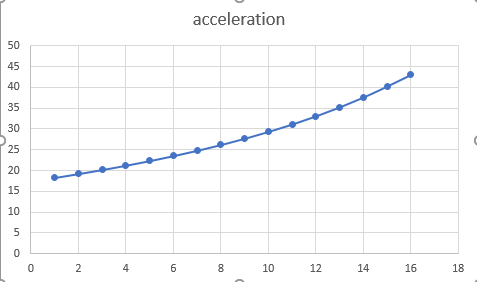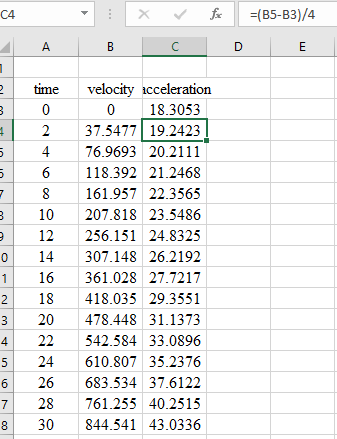
The upward velocity of a rocket can be computed by the following formula:
Where
To calculate: The height of the rocket at
Answer to Problem 46P
Solution:
All the results are summarized in the table below,
Acceleration graph is shown below.

Explanation of Solution
Given Information:
The formula for the upward velocity of rocket is given as,
Here,
Formula Used:
6-segment Trapezoidal rule.
6-segmentSimpson’s 1/3 rule.
Change of variable formula.
Here,
Error Calculation.
Calculation:
Calculate the upward velocity of the rocket.
Substitute thegiven values in equation(1),
Apply 6-segment Trapezoidal rule for
Here,
Substitute
Expand the above terms.
Calculate
Substitute
Calculate
Substitute
Calculate
Substitute
Similarly, calculate all the function values.
Substitute above values in equation(3),
The formula for 6-segment Simpson’s 1/3 rule,
Substitute the function values from above,
The given velocity Integral is,
Change of variable before integrating the function,
And
Here,
Substitute the values of
Substitute the values of
Thus, the transformed function is,
Apply Six-Point Gauss Quadrature formula.
Calculate
Substitute
Calculate
Substitute
Similarly, calculate all function values.
Substitute the values in Six-Point Gauss Quadrature formula.
Apply Romberg Integration.
Choose
Substitute value from above and calculate
Choose
Substitute values from above and calculate
Choose
Substitute values from above and calculate
Choose
Substitute values from above and calculate
Substitute values from above and calculate
Calculate the approximate error,
Substitute values from above.
Substitute values from above and calculate
Substitute values from above and calculate
Substitute values from above and calculate
Calculate the approximate error,
Substitute values from above,
Substitute values from above and calculate
Substitute values from above and calculate
Calculate the approximate error as,
Substitute values from above.
All above calculated results are summarized in the table below,
UseNumerical differentiation to calculate acceleration as a function of time.
Apply finite-divided differences for
Apply centred differences to calculate the intermediate values,
Similarly, calculate all intermediate values of acceleration.
Apply backward difference for the last value at t = 30 s,
All of the results are displayed in the following table and graph,

Select the time and acceleration column and go to insert chart and scattered chart. The graph of acceleration verses time is plotted as follows:

Want to see more full solutions like this?
Chapter 24 Solutions
EBK NUMERICAL METHODS FOR ENGINEERS
- Q Calculate the Fourier series for f(x) = x on the interval -16≤x≤ Tarrow_forwardFind all positive integers n such that n.2n +1 is a square.arrow_forwardA straight-line H is tangent to the function g(x)=-6x-3+ 8 and passes through the point (- 4,7). Determine, the gradient of the straight-line Choose.... y-intercept of the straight-line Choose... + which of the following is the answers -1.125 -6.72 1.125 7.28 0.07 - 7.28 6.72arrow_forward
- You are required to match the correct response to each statement provided. Another term/word that can be used synonymously to Choose... gradient. A term/phrase that is associated with Arithmetic Progression. Common difference → An identity matrix can be referred to as a Choose... ÷ What is the inequality sign that represents "at most"? VIarrow_forwardAffect of sports on students linked with physical problemsarrow_forward26.1. Locate and determine the order of zeros of the following functions: (a). e2z – e*, (b). z2sinhz, (c). z*cos2z, (d). z3 cosz2.arrow_forward
- 31.5. Let be the circle |+1| = 2 traversed twice in the clockwise direction. Evaluate dz (22 + 2)²arrow_forwardUsing FDF, BDF, and CDF, find the first derivative; 1. The distance x of a runner from a fixed point is measured (in meters) at an interval of half a second. The data obtained is: t 0 x 0 0.5 3.65 1.0 1.5 2.0 6.80 9.90 12.15 Use CDF to approximate the runner's velocity at times t = 0.5s and t = 1.5s 2. Using FDF, BDF, and CDF, find the first derivative of f(x)=x Inx for an input of 2 assuming a step size of 1. Calculate using Analytical Solution and Absolute Relative Error: = True Value - Approximate Value| x100 True Value 3. Given the data below where f(x) sin (3x), estimate f(1.5) using Langrage Interpolation. x 1 1.3 1.6 1.9 2.2 f(x) 0.14 -0.69 -0.99 -0.55 0.31 4. The vertical distance covered by a rocket from t=8 to t=30 seconds is given by: 30 x = Loo (2000ln 140000 140000 - 2100 9.8t) dt Using the Trapezoidal Rule, n=2, find the distance covered. 5. Use Simpson's 1/3 and 3/8 Rule to approximate for sin x dx. Compare the results for n=4 and n=8arrow_forward1. A Blue Whale's resting heart rate has period that happens to be approximately equal to 2π. A typical ECG of a whale's heartbeat over one period may be approximated by the function, f(x) = 0.005x4 2 0.005x³-0.364x² + 1.27x on the interval [0, 27]. Find an nth-order Fourier approximation to the Blue Whale's heartbeat, where n ≥ 3 is different from that used in any other posts on this topic, to generate a periodic function that can be used to model its heartbeat, and graph your result. Be sure to include your chosen value of n in your Subject Heading.arrow_forward
 Algebra: Structure And Method, Book 1AlgebraISBN:9780395977224Author:Richard G. Brown, Mary P. Dolciani, Robert H. Sorgenfrey, William L. ColePublisher:McDougal LittellAlgebra & Trigonometry with Analytic GeometryAlgebraISBN:9781133382119Author:SwokowskiPublisher:Cengage
Algebra: Structure And Method, Book 1AlgebraISBN:9780395977224Author:Richard G. Brown, Mary P. Dolciani, Robert H. Sorgenfrey, William L. ColePublisher:McDougal LittellAlgebra & Trigonometry with Analytic GeometryAlgebraISBN:9781133382119Author:SwokowskiPublisher:Cengage
 College Algebra (MindTap Course List)AlgebraISBN:9781305652231Author:R. David Gustafson, Jeff HughesPublisher:Cengage Learning
College Algebra (MindTap Course List)AlgebraISBN:9781305652231Author:R. David Gustafson, Jeff HughesPublisher:Cengage Learning



